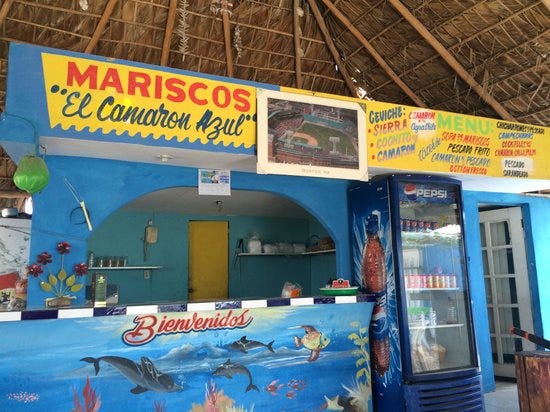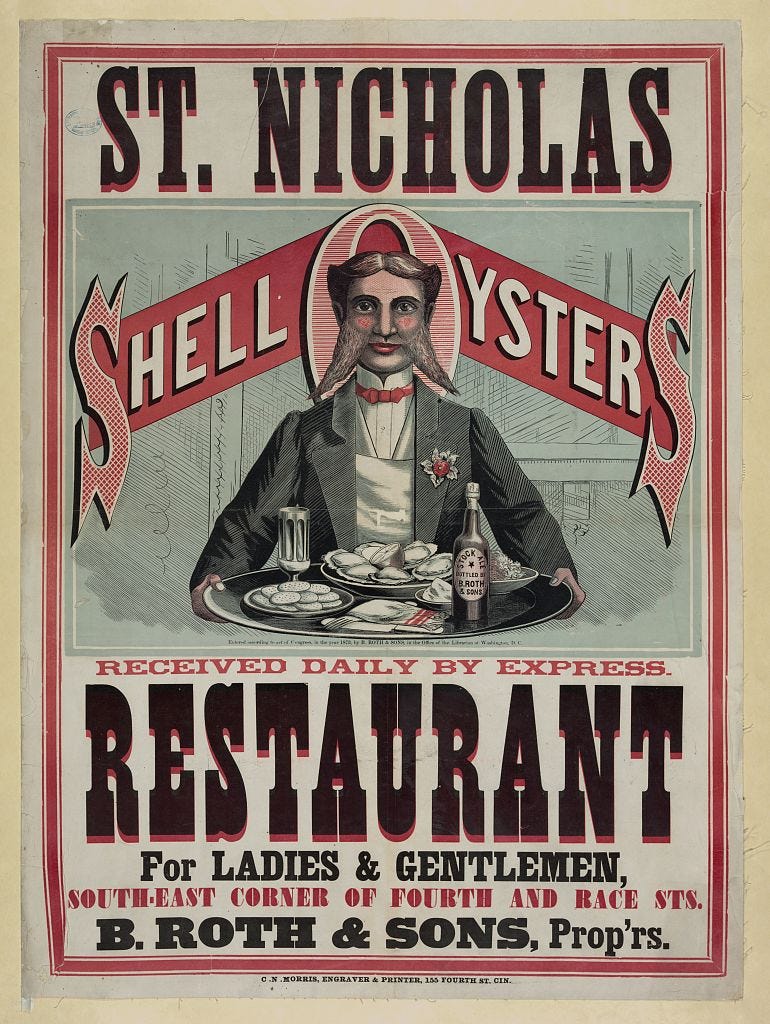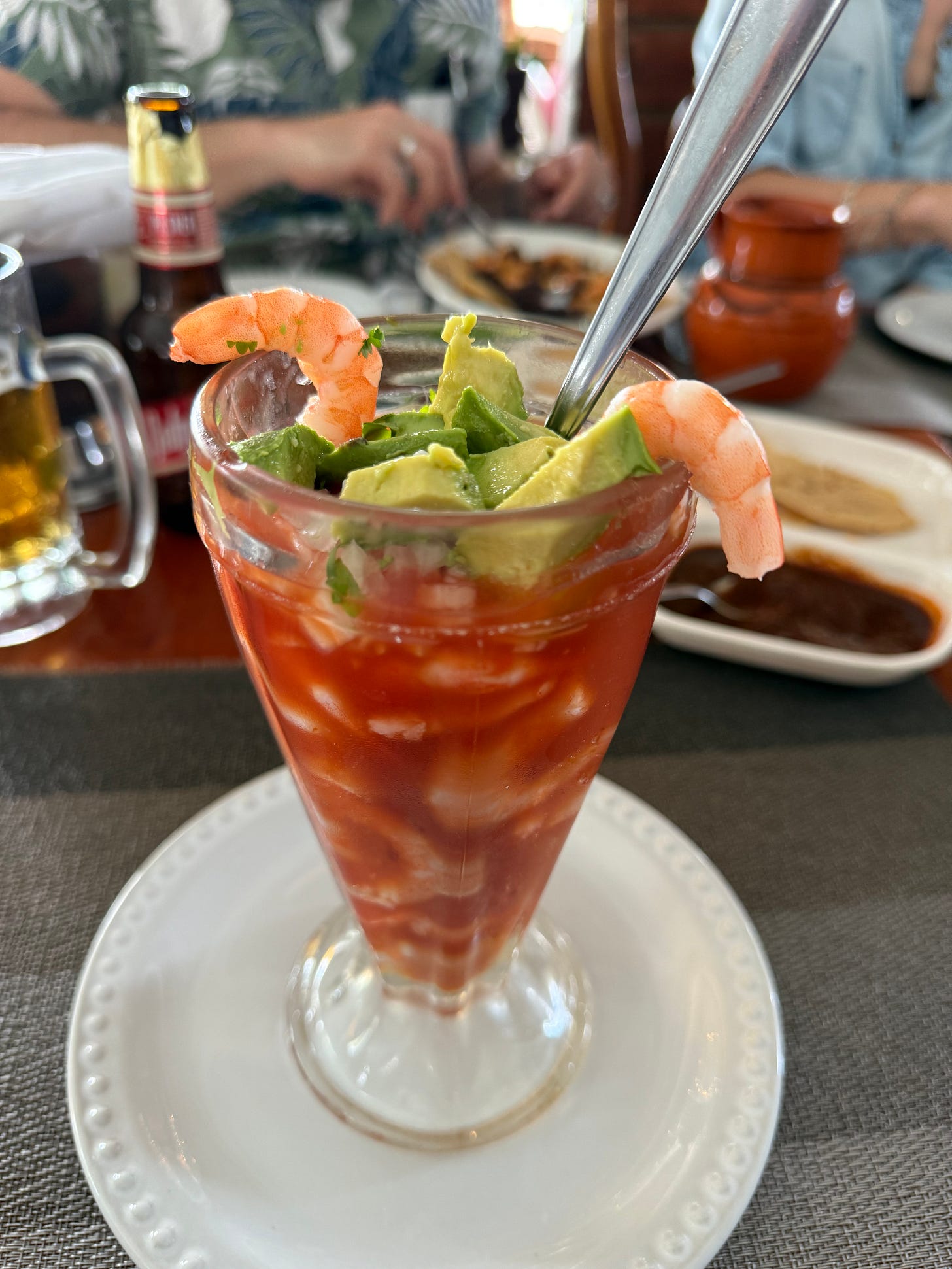Most people in the US associate Mexican food with tacos and burritos, enchiladas and tamales, beans and rice. People think of carne asada, perhaps, or pork cooked al pastor. Or maybe the glorious Mexican grilled chicken. The language of American-style Mexican food evokes the street foods of Tijuana and Mexico City, or the cattle ranches of the great Northern plains- huevos rancheros, ranchers’ eggs, or frijoles charros, cowboy beans. There is much to love about all of these dishes, of course, but sadly, most American eaters forget- or never know- about Mexican seafood.
The attitude most Mexicans have about about seafood is, in a word, joyful. Mexicans love to travel, and especially appreciate family trips to the beach. And no beach trip would be complete without seafood feasts, ideally eaten while sitting in a plastic chair at a beachside palapa. An abundant meal of seafood evokes memories of sandy feet and warm breezes, children laughing and playing, festive music and cold beer. To go to a seafood restaurant is to either 1. be at the beach or 2. To remember being at the beach. This is the delight of Mexican seafood- it is a celebration of being at the seaside, with all the happiness that evokes.
For this reason, to the surprise of many outside the culture, Mexican-American neighborhoods are filled with seafood restaurants. Most commonly, their name begins with the word Mariscos, meaning “seafoods”. The next word will generally be the name of a port or beach town, like Ensenada or Veracruz, or a coastal state like Jalisco or Colima. Or there are the playful names, like Mariscos el Pescado Loco or, my favorite, Mariscos El Cangrejo “Nice”. Marisquerias are generally decorated with plastic crabs and palm fronds, twinkly lights and painted beach scenes. And the best thing on the menu is likely to be the coctel de camaron: Mexican Shrimp Cocktail.
Though Mexico perfected the shrimp cocktail, it did not invent it. That happened a few hundred miles north, in the Californian city of San Francisco. Evidence points to the late 19th century- during the gilded age, in the wake of the California gold rush- as the moment the seafood “cocktail” was created. But this cocktail wasn’t based on shrimp- it was based on oysters.
Oysters were huge in the 1800s. I mean HUGE. For most of the century, oysters from the Chesapeake Bay and other East coast inlets were inexpensive and abundant. And- even better- they could be packed in barrels with seaweed where they could live for weeks without refrigeration: they would be shipped all over the country aboard the new trains and stagecoach lines that were just then crisscrossing the nation. For this reason, live oysters could be found on menus throughout the country, deep into the Midwest and even farther, from Cincinnati to Chicago, to Denver and beyond. This was the 19th century oyster craze, which led to a huge consumption of the bivalves across the United States. Even the mining towns of the old West had an oyster barrel in the saloon. San Francisco, of course, had its own native oysters. And, in the boom-town growth of the Bay Area after the Civil War, people ate oysters like crazy.
Meanwhile, there was another craze afoot: the cocktail. 19th Century drinkers were cocktail-mad, after the concept of liquor-based mixed beverages caught on (earlier imbibers favored straight liquor). Jerry Thomas, the first celebrity bartender, toured the country visiting hotel bars and saloons, serving his signature concoctions (many of them called “cocktails”). Before long, every bar was making cocktails out of every possible ingredient- liquor or otherwise.
Finally, the last crucial component, which was also a food craze during the 1800s: ketchup. The first recipe for tomato ketchup was published in 1812, and the condiment caught on for its sweet-and-savory flavor and long shelf life. By the time H.J. Heinz introduced his brand of tomato ketchup in 1876, the sauce was well on its way to being the classic American condiment.
The time, place, and ingredients were right: some bartender somewhere in San Francisco in the 1880s mixed shucked oysters, ketchup, and a few seasonings together, served them in a big glass, and called it an “Oyster Cocktail”. By 1889, the following recipe was printed in the Chicago Tribune, describing the oyster cocktail as a San Francisco “institution”:
“Put half a dozen to a dozen small oysters into a goblet or beer glass, with enough of the (oyster) liquor to cover them. Salt, pepper, catsup, a dash of Tobasco sauce, half a spoonful of Worcestershire, two or three spoonfuls of vinegar, and sometimes a pinch of horseradish. Stir it up with a spoon and drink it down.”
The oyster cocktail was especially renowned as a foolproof hangover cure. Sounds pretty good to me!
But the oyster cocktail didn’t last. Due to the oyster craze, oysters became overfished everywhere in the United States, and the market collapsed. But fortunately, there was a substitute at hand: cooked shrimp made a delicious seafood “cocktail” too, and pretty soon the shrimp cocktail replaced the oyster cocktail as a standard item at bars and restaurants. Hooray! However, the good times didn’t last. The next problem was a culinary one- the shrimp cocktail’s immense popularity led to its debasement, and the dish withered from an exuberant bartender’s concoction to a pallid combo of cooked shrimp alongside a splotch of insipid, industrial cocktail sauce. This was the shrimp cocktail I grew up knowing and despising. I consider the Costco Shrimp Cocktail to be the very symbol of a food having lost its way- rubbery, smelly shrimp with cloying ketchup reeking of horseradish. How depressing. I’ll pass, thanks.
Thankfully, there was an heir to the seafood cocktail at the playas south of the border. In Mexico, the coctel de camaron maintained its almost-a-drink-served-in-a-chilled-glass cocktail identity, and it only got better from there. The poaching liquid from the shrimp was dosed with ketchup, cilantro, fresh chiles, onions, and tomatoes, and served as a cold soup to elevate the shrimp to a state of pure deliciousness. Next, oysters re-entered the scene, creating the shrimp-oyster combo cocktail known as campechana, from an odd word meaning “mixture”. But that’s not all- the hangover-cure reputation of the seafood cocktail returned in the form of the coctel vuelve a la vida (“brings back to life cocktail”), a seafood cocktail loaded with octopus, oysters, clams, and shrimp and served in a giant goblet. Cocteles are invariably served with saltine crackers (galletas saladas) on the side, but a tostada is great too.
I have it on good authority that the epicenter of the Mexican shrimp cocktail is in Veracruz, Mexico where it is sometimes known as the coctel Jarocho (“Jarocho” is the nickname for residents of Veracruz). I have also heard that the best cocteles come from Campeche, which may explain the odd name of the campechana. I happen to have had a lovely coctel de camaron in Veracruz just this week- here’s a photo:
Here’s my recipe for cocteles de camaron for two. you need-
1 pound uncooked shrimp, fresh or frozen (I buy shell-on deveined shrimp because I use the shells)
1 roma tomato
1/2 cup ketchup
1 serrano or jalapeño pepper
a handful of cilantro
1/4 red or white onion
juice of 1/4 Mexican or American lemon
1 ripe avocado
saltine crackers or tostadas
two tall glasses, ideally goblets or sundae glasses, chilled
First, clean the shrimp and reserve the shells. Poach the shrimp in 2 cups of simmering water until just barely cooked and still tender, then remove and chill the shrimp on ice in the refrigerator.
While the broth is still simmering, add the shrimp shells to flavor the broth, along with a little salt. Simmer for a few minutes, then strain into a pitcher or bowl. Let cool.
Next, dice the tomatoes, onions, chile, and cilantro fine. Mix everything plus the lemon juice and the ketchup into the poaching broth, tasting and correcting the salt. If you want it a bit sweeter, add more ketchup. If you want it spicier, add a dash of hot sauce like Valentina or Tapatío. Chill thoroughly in the refrigerator, at least 1 hour.
When ready to eat, mix the shrimp into the broth, then ladle equally into the chilled glasses. Top with sliced avocado and serve with crackers or tostadas on the side. You can decorate with more shrimp or lemon slices. You’re living the dream now.
p.s. If you don’t have shells to enrich the broth, you can use clam juice or Clamato to boost the seafood flavor.
p.p.s. I have it on good authority that Orange Crush is often used as a “secret ingredient” in Mexican shrimp cocktails. While I have no reason to doubt this, I cannot in good conscience recommend its use; though I am fond of Orange Crush as a soda, I keep it away from my seafood, thank you.








Thank you for validating my life long aversion to the current American shrimp cocktail. I look forward to trying your authentic version.
love it! Do you think there’s any relationship (besides a culture’s affinity for chilled seafood) between the shrimp coctel and aguachile, the sinaloan raw shrimp dish?